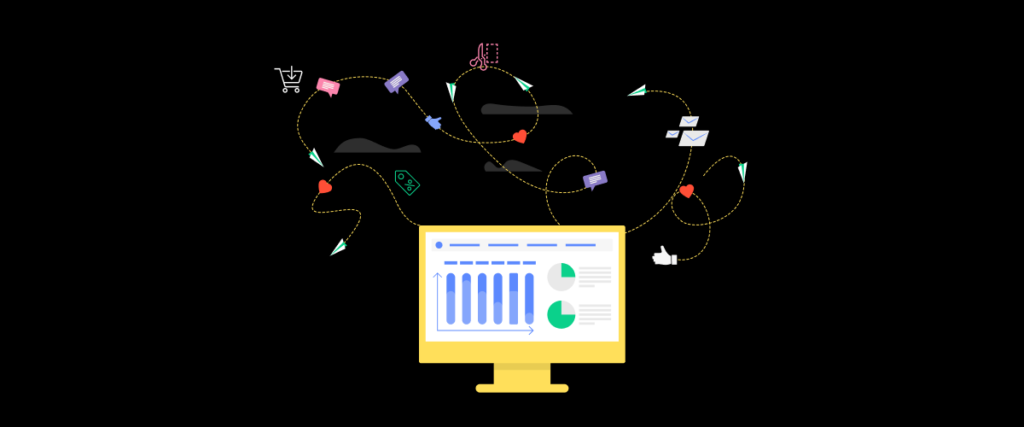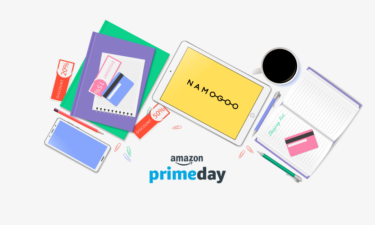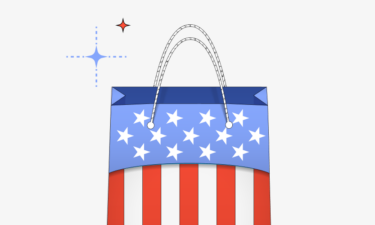Updated on Aug 10, 2022
Bonus Material: 3 Proven Customer Intent Campaigns for The Best BFCM Yet
Wouldn’t it be nice to have a crystal ball that lets you see into the future and helps you plan your 2022 Black Friday marketing strategy?
While we can’t offer magic like that, this guide may be the next best thing.
We’ll be taking a data-driven dive into Black Friday sales statistics over the last three years, so you can see and use the latest research to get ahead of your competition this holiday season.
You’ll learn how the evolving situation with the COVID-19 pandemic affected Black Friday sales figures in 2021, and how the pandemic coming to an end may impact 2022’s biggest sales event of the year.
We’ll also share some Black Friday marketing ideas and provide you with five strategies to implement this year to drive sales and increase conversions.
So if you’re ready to boost your customers’ Black Friday spending, check out a preview of the Black Friday sales statistics, trends, and tips we’ll be exploring in this guide.
eCommerce Black Friday Statistics: A Year-Over-Year Review
Here’s what the most recent Black Friday statistics by year show:
1. Omicron Paved The Way for the Strongest Holiday Season Yet, With Online Spending Passing $100 Billion by Cyber Monday (One Day Earlier Than 2020)
Despite the fact that 2020 was the year the global pandemic started, key COVID-19 variants cropped up during the fall of 2021, namely the Omicron variant. This highly contagious variant resulted in increased restrictions and thus, more people staying inside…Just in time for Cyber Week 2021.
It’s thanks in one part to Omicron, and the other in part to consumers becoming even more comfortable with online shopping that 2021 broke several holiday online shopping records by a landslide.
Here’s what 2021’s Black Friday Cyber Monday sales numbers have to say:
- 2021’s online shopping mania resulted in the first $200 billion + online shopping holiday season[*]
- 2021’s Cyber Week saw US online spending surpass $100 billion by Cyber Monday, one full day earlier than in 2020[*].
- Despite the stronger sales figures overall, Black Friday 2021 saw a 1% drop in revenue from the previous year, landing at $8.9B.
To put this into perspective, Black Friday sales figures clocked in at $6.2 billion in 2018, $7.4 billion in 2019, and $9 billion in 2020.
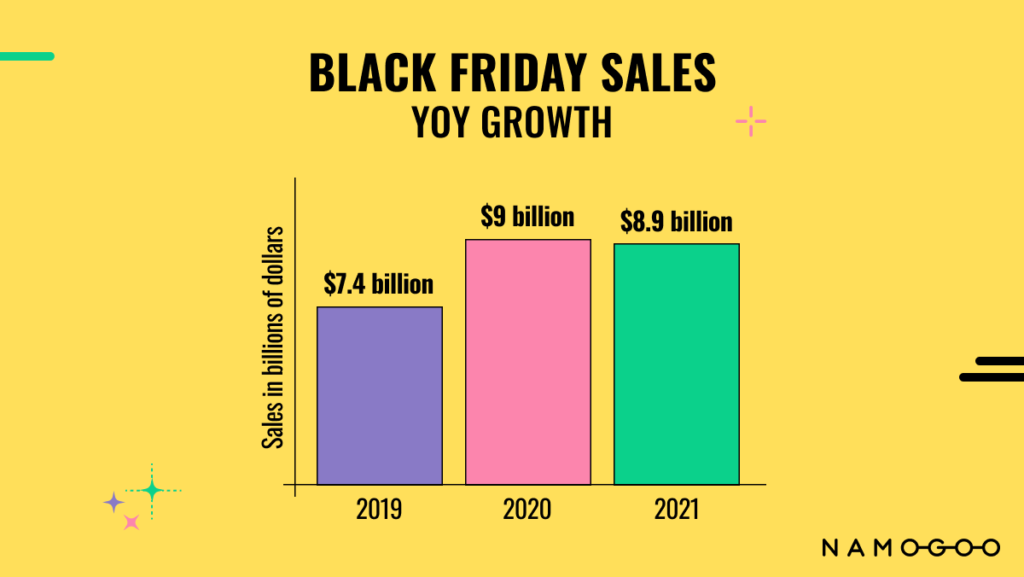
2. Economic Uncertainty Paired with Inflation and Supply Chain Issues Had a Leveling Effect on Consumer Spending
While 2021’s holiday shopping season did result in the highest online sales revenue in history, hints of an impending recession and the rising cost of living due to an accelerated rate of inflation had a leveling effect on sales figures.
As with every year, online retailers experienced a front-loaded start to the holiday shopping window starting on Black Friday.
However, unlike other years, Thanksgiving, which landed on Thursday, November 25, was the only day to show an increase in spending year over year[*].
This means that rather than focusing shopping efforts solely on Black Friday and Cyber Monday, consumers continued to check items off of their holiday shopping lists leading up to the New Year.
One possible explanation for this is the reduction in size of discounts offered by brands to shoppers. Supply chain disruption and increasing cost of goods drove retailers to offer smaller promotional discounts over BFCM by an average of 5% across product categories.
Some categories saw a steeper reduction in discounting, like Appliances (-10%), Computers (-12%) and Electronics (-13%)[*]. These happen to be some of the most sought-after products for consumers looking to snag a Black Friday deal.
3. Black Friday Conversion Rates Dropped in 2021
Despite a record-breaking holiday shopping season overall, average eCommerce conversion rates dropped in 2021 over the previous year by just over 20%, landing just under the 2019 number.
Our analysis of over two billion eCommerce store session data every single week showed that the average conversion rate globally for Black Friday in 2021 was 3.2%, compared to 4.5% in 2019.
The US scored slightly better than the global average, with conversion rates at 3.6% in 2021, vs 4.3% in 2020.
Canada saw an impressive 7.4% conversion rate in 2021, up from 4.1% in 2020. The UK rang in at 4.3% for 2021, vs 4.1% in 2020.
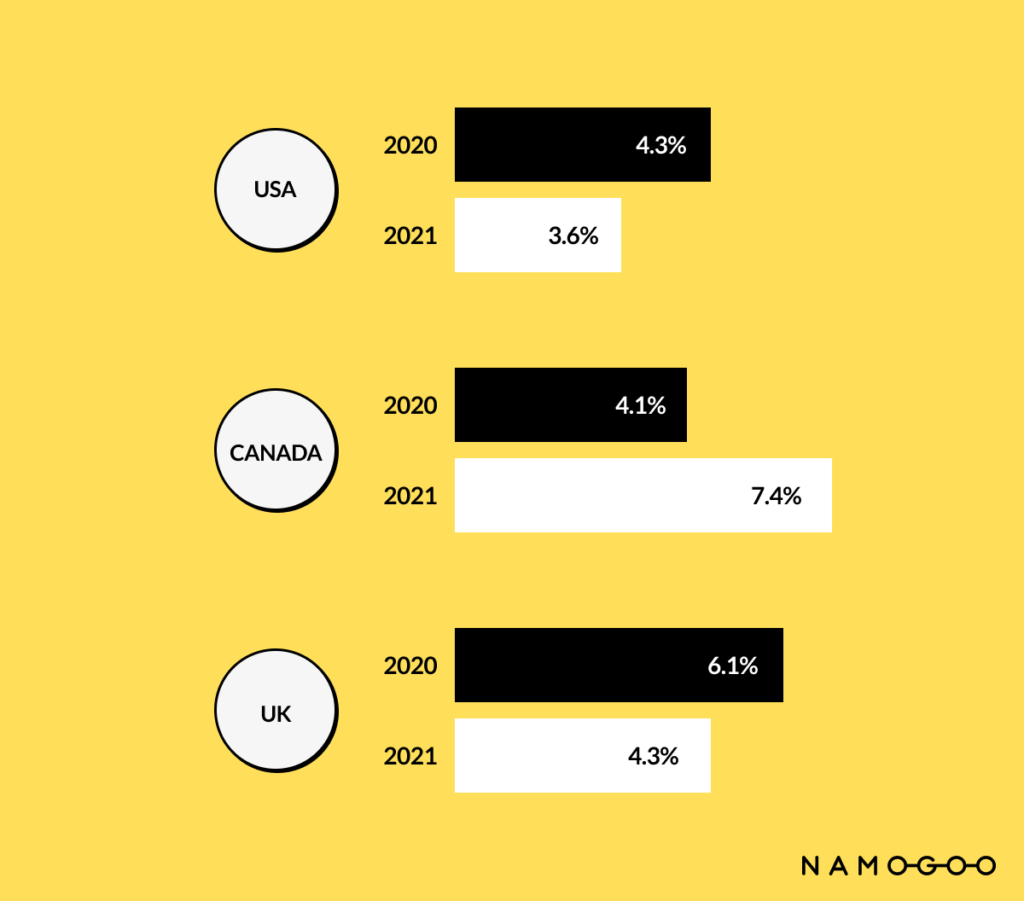
4. Black Friday vs. Cyber Monday: Here’s What the Data Shows
Cyber Monday is relatively new when compared to Black Friday. The Black Friday shopping event began in brick-and-mortar retail stores before online shopping was as prevalent as it is today.
But given the accelerating pace of eCommerce and the fact that now more than ever, consumers are shifting toward digital, many eCommerce teams struggle to figure out which day to put most of their focus on.
In 2020, Cyber Monday’s traffic numbers fell behind Black Friday’s by over 21%. The conversion rate fared even worse by 26%.
During 2021’s BFCM, the gap between Black Friday and Cyber Monday narrowed from the previous year, with Cyber Monday bringing in more traffic relative to 2020. Still, Cyber Monday saw 14.7% fewer sessions than Black Friday’s traffic numbers.
The gap closed even further when it came to conversion rate. In 2020, Cyber Monday’s conversion rate lagged Black Friday’s by 26%, compared to just 7% in 2021.
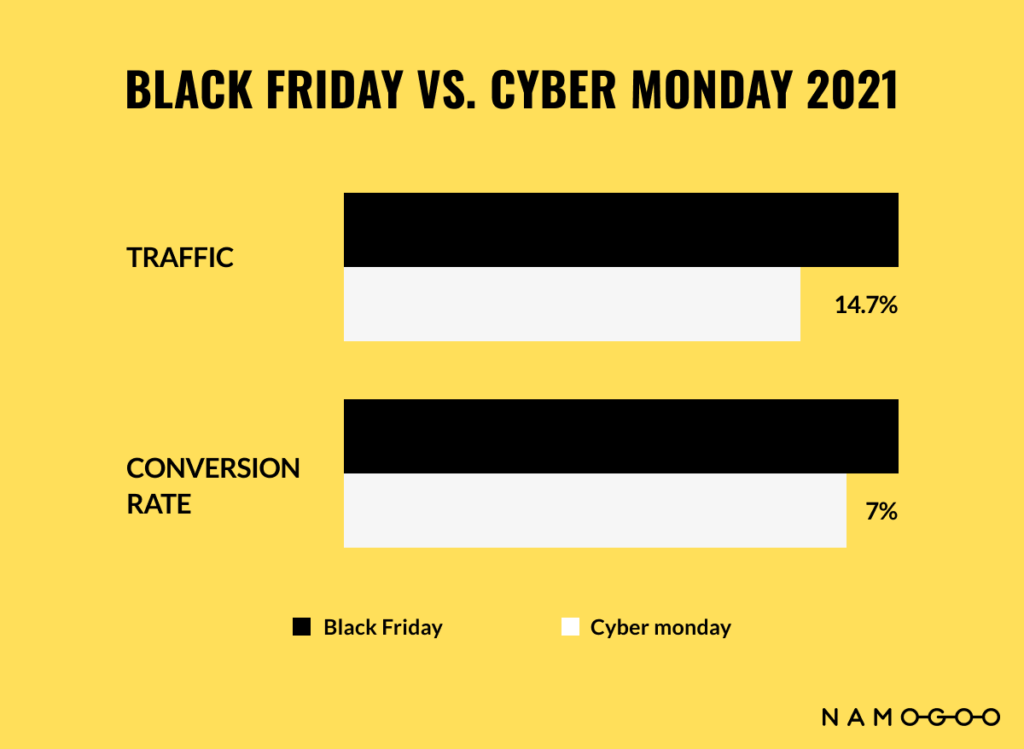
Despite Cyber Monday ringing in fewer sessions than Black Friday’s shopping window, the conversion rate improvement helped to offset that, with Black Friday bringing in $8.9B in online revenue, and Cyber Monday exceeding it with $10.7B in sales[*].
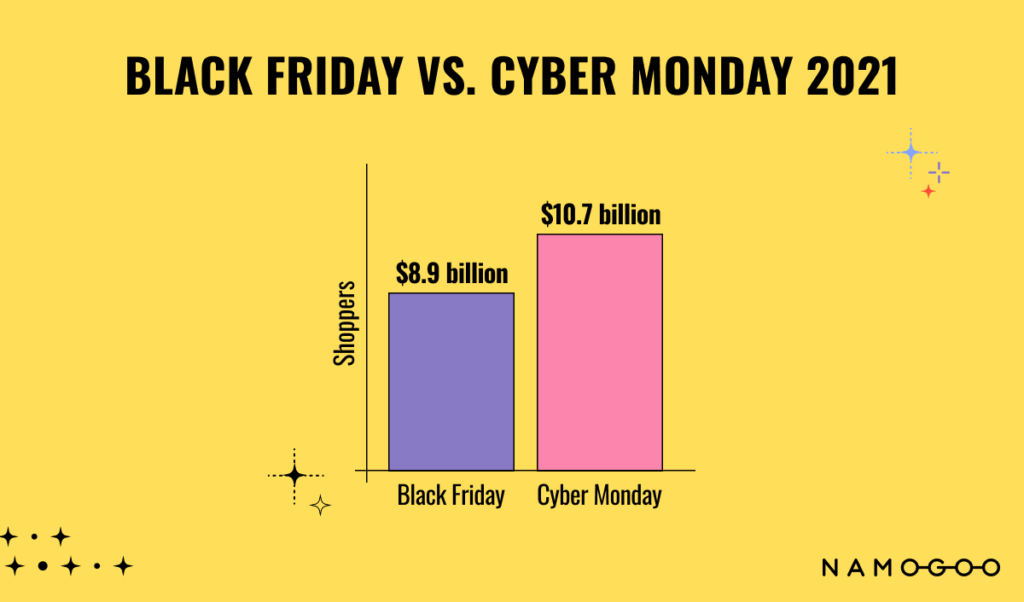
Despite these Black Friday vs Cyber Monday statistics, avoid structuring your sales promotion campaigns based on either of those data points alone.
Whether your team should spend more time on your Black Friday vs. Cyber Monday promotion depends on the industry your eCommerce store is in.
Consumers choose to shop on Black Friday or Cyber Monday depending on what they’re looking for.
Black Friday is notoriously better for consumers looking to capture sales on big-ticket items like electronics, whereas Cyber Monday is more effective for smaller gifts such as clothing, toys, and home goods.
And since we are moving toward a post-pandemic world, we can expect shopping habits to return to relative normal.
5. BFCM Shopping and Browsing Statistics by Device
As usual, mobile continues to lead the way in eCommerce, and brands that can nail the mobile experience will benefit from reduced cart abandonment rates, higher conversions, and a better UX.
2021’s cyber weekend statistics found that, again, the majority of shoppers do their online BFCM shopping on their mobile devices.
eCommerce teams must optimize their mobile shopping experience now and long before the holiday season approaches.
Not only does this provide a seamless user experience, which is a necessity for improving conversion rates, search engine rankings, average order values, and cart abandonment rates, but our data shows that:
- Over 71% of online shoppers visited retail websites via their mobile devices
- Nearly 54% of BFCM conversions happened on mobile in 2021.
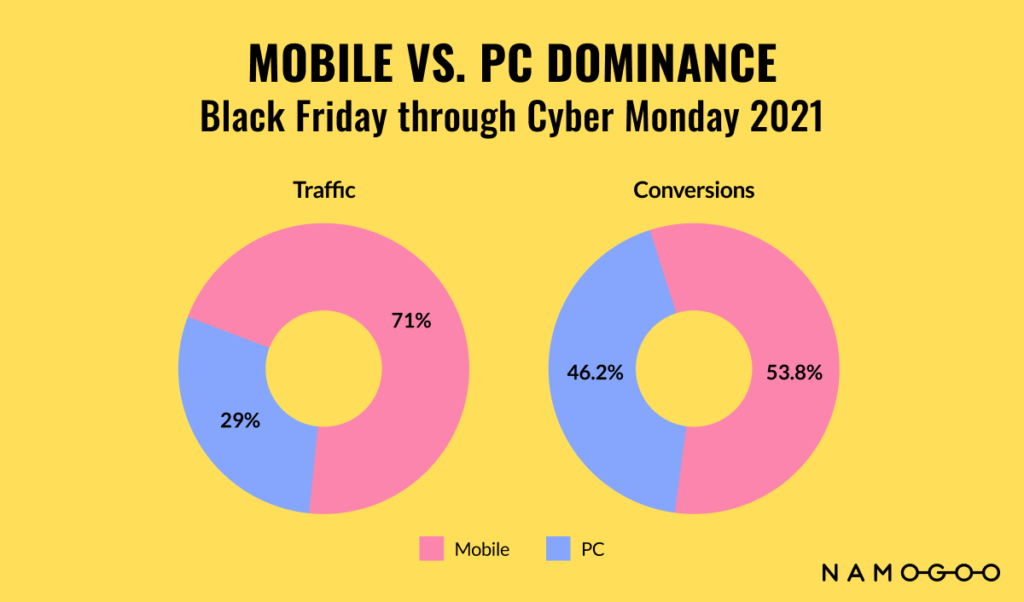
Including mobile cyber weekend stats might seem passé. But despite the prevalence of mobile, statistics suggest eCommerce brands have a long way to go to perfect the mobile shopping experience.
Our data also shows that mobile shoppers still abandon their carts at a much higher rate than tablet or desktop users. 2021’s Black Friday saw average cart abandonment rates per device clock in at:
- Mobile: 73.8%
- PC: 64.8%
- Tablet: 68.5%
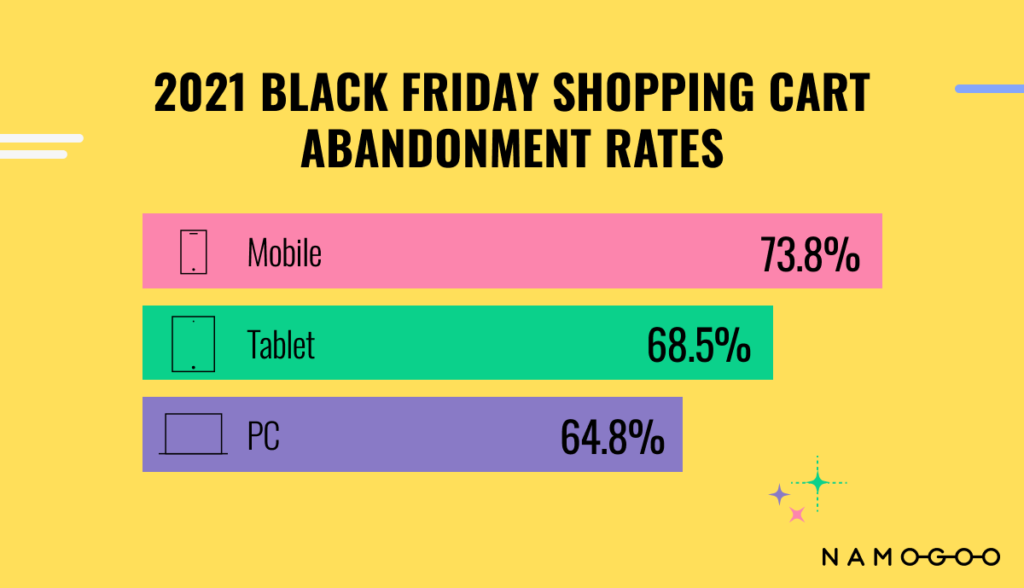
Honing in on the mobile experience for your 2022 Black Friday strategy can go a long way to make this year your best BFCM yet.
Optimize Your Mobile View for Older Shoppers
If you think it’s just Millennials and Zoomers using their mobile devices to browse for deals, think again.
Many of the online shoppers just mentioned are in the 60+ age category[*], which means your mobile experience should cater to an older demographic.
You’ll want to adjust your font sizes for mobile devices (bigger is better!) and ensure that items aren’t too close together. You don’t want mobile website shoppers accidentally clicking the wrong things, getting frustrated, and leaving before converting.
6. Cyber Weekend Website Traffic Statistics
Regardless of the device your visitors use, your eCommerce team needs to be prepared for a major spike in traffic over the four-day cyber weekend shopping event.
When compared to a regular, non-holiday weekend, eCommerce stores have seen a sustained increase in the number of sessions year over year.
- + 197% in 2018
- + 94% in 2019
- + 57% in 2020
- + 92% in 2021
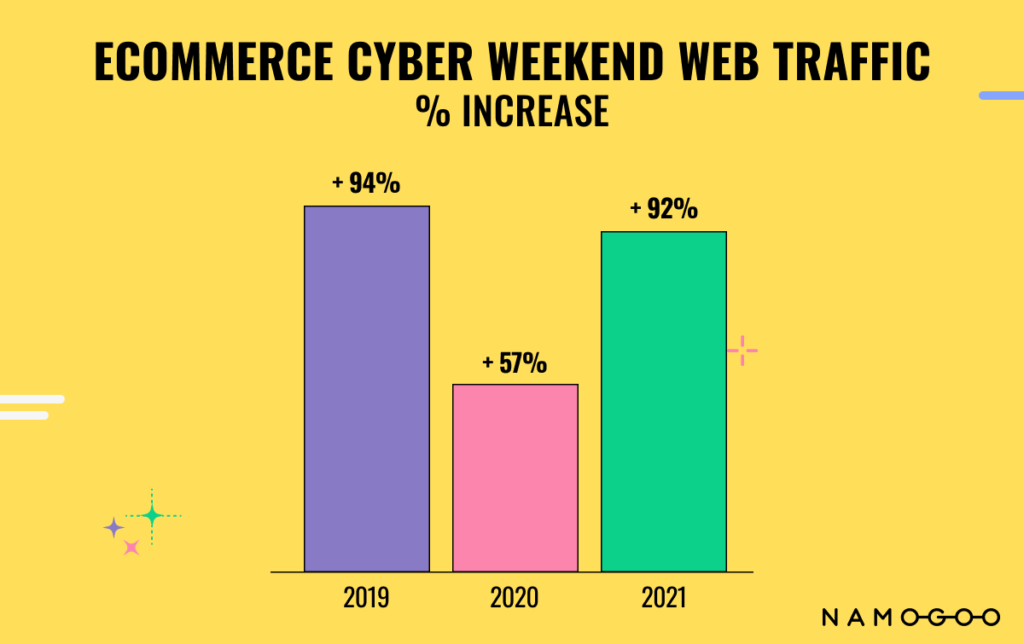
The biggest increase is on Black Friday, accounting for around 30% of the weekend’s session spike each year, followed closely by Cyber Monday at around 26%.
Saturday and Sunday do account for 45% of site traffic during Cyber Weekend, however, these days saw a 10% lower conversion rate than Black Friday and Cyber Monday.
This data suggests that online shoppers are still browsing during these lower sales days, but may be holding out for deals on Monday.
While typically these numbers don’t garnish upgrading your web servers, you would do well to be prepared for a spike in sessions over the BFCM weekend.
Many Retailers Start BFCM Promotions Before Cyber Weekend Hits
2022’s Black Friday falls on November 25.
However, if you wait until that exact date to launch your promotion strategy, you may find that your customers have already spent their money elsewhere, leaving little to spend with you.
That’s why the following findings hold true for eCommerce teams.
Some Retailers Start Promoting Their Black Friday Deals Weeks Ahead
Many retailers kick off their Black Friday sales as early as late October, while others begin promotions in early November.
In addition, 75% of retailers surveyed in 2020 said they offered deals before Black Friday, with some lasting several days or weeks at a time[*].
With the supply chain issues we’ll review later, many retailers stuck to a schedule closer to the big day in 2021, and consumers developed their own Black Friday strategies.
83% of consumers surveyed stated that they started their holiday shopping much earlier than Black Friday, and with the persistent economic uncertainty, it is likely that 2022 will bring in the same.
eCommerce Stores Also Extended Their Cyber Monday Specials
Don’t be surprised if you see retailers extending their Cyber Monday deals up to one week after the date to capture customers who were on the fence.
This strategy allows eCommerce brands to stand apart from the other promotions cluttering the feeds and inboxes of consumers over the four days that make up Cyber Weekend.
Consumers Shop All Weekend
The cyber-weekend focus for many eCommerce stores is on Black Friday and Cyber Monday, and rightfully so given these Black Friday sales statistics.
But consumers are committed to shopping all weekend, not just over the two biggest sales days.
The Saturday following Black Friday has been coined Small Business Saturday in an effort to counterbalance the spending frenzy with the world’s largest retailers. In 2021, sales on Small Business Saturday dropped by just over 4% from the year prior, with Sunday dropping 1.4% from 2020[*].
Regardless of the modest decline, the entire weekend is a notable shopping event, so if your company falls into the “small business” category, you can use this as a point of leverage on Small Business Saturday.
Black Friday Trends: These Product Categories See the Biggest Sales Boosts During Cyber Week
If you’re looking for Black Friday trends, you may find yourself in a bit of a predicament.
After all, the word “trend” necessitates a pattern and predictability, and the last few years have been anything but predictable.
2020 brought with it a global pandemic that flipped the world on its head and made for an unusual year for online shopping.
2021 ended with the world’s strongest economies in flux, the rapid rate of inflation, natural disasters aplenty, and a supply chain crisis to top it off.
So far 2022 has brought on Russia’s invasion of Ukraine, the beginnings of an economic downturn and speculation around a recession for the US, Canada, the UK, and across Europe.
These signals following the previous two years indicate that online retailers may be in for a relatively quiet Black Friday. Even so, it’s still the biggest shopping event of the year, and with the grumblings of tougher times, consumers could be on the lookout for deals.
Brands in the most popular product categories tend to see growth around BFCM and should prepare accordingly.
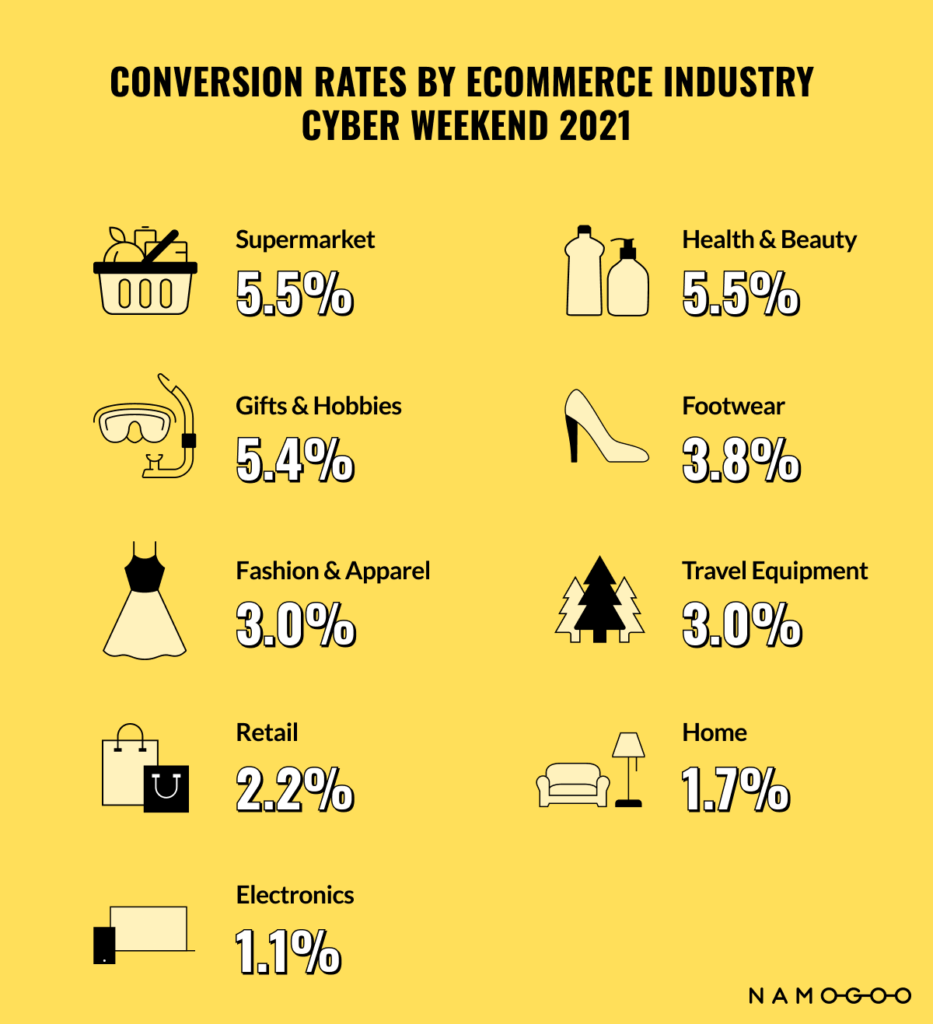
1. Electronics and Household Appliances Traditionally Lead the Black Friday Way
Consumers have always turned to Black Friday deals to score discounts on TVs, electronics, gaming consoles, smart devices and phones, power tools, and kitchen appliances (think: Roombas, Air Fryers, and large appliances like refrigerators)…
Until 2020.
In 2019, online sales for electronics saw a 711% increase sales over BFCM.
But then the pandemic happened, and the consumer goods categories overshadowed these previous top-performers as the world dealt with lockdowns and restrictions.
2021 continued to trend away from the historical winners, but not in the same way as 2020. The winning categories clocked in as toys, video games, gift cards and books, all surpassing 3x their regular sales volume.
2. Like in 2020, Supermarket and Health & Beauty
Despite the four categories listed above’s sales figures, 2021’s top categories in terms of performance (that is, conversion rates) scored differently.
2021’s Black Friday performance saw the strongest conversion rates in health and beauty, online supermarket, and gifts and hobbies.
This makes sense in the context of the type of year 2021 was.
Computers, once a hero of Black Friday, saw the lowest conversion rate.
3. A Supply Chain Crisis Led to Record-Breaking Inventory Issues
Looking at the category data paints an interesting picture of 2021, but it’s tough to know the cause of the drops for more traditionally sought-after products.
The pandemic certainly contributed, as did the natural disasters that devastated all over the globe.
But among the most impactful events to influence the Black Friday statistics is the supply chain crisis that depleted certain product categories’ inventory. Brought on by lockdowns, labor shortages, and sharp changes in demand, consumers received more than 6 billion out-of-stock notifications over the busiest shopping season of the year.
While all this Black Friday data falls under the “nice to know” category, it’s only helpful if you can put it to good use in your Black Friday and Cyber Monday campaigns.
Fortunately, this next section will help you do just that.
How to Use This Data in Your Own Black Friday and Cyber Monday Promotions and Plans
Use these five strategies in your 2022 Black Friday and Cyber Monday campaigns to boost sales, increase conversions, and reduce your cart abandonment rate:
1. Protect Your eCommerce Margins this Holiday Season
Steep, blanket discounts, free expedited shipping, and high fulfillment fees make cyber weekend tough on a brand’s margins.
So rather than harnessing Black Friday and Cyber Monday to drive profit, most eCommerce companies find themselves with little to invest back into growth at the end of the weekend.
But it’s not as simple as just reducing your discounts for the weekend. You need to put your best foot forward to stay competitive.
Your biggest tool to overcome this is to capture those pivotal moments of conversion through customer intent.
Some cyber weekend shoppers will have high intent to purchase and won’t require as steep a discount to convert. Others may be browsing or comparing deals, and require a more generous offer to complete their orders.
Tailoring the promotion each visitor sees on Black Friday to each individual customer not only drives revenue but also protects margins by reducing your average discount rate.
This is why we built Intent-Based Promotions: to serve a one-to-one customer onsite experience based on customer intent.
It works by calculating shoppers’ purchasing patterns and intent to determine the right offer for each specific customer during their session, based on behavioral and intent signals:

When you’re crafting your Black Friday promotions, you might decide on a maximum discount of 30%, and let the “brain” decide which customers require that maximum discount to convert, vs. which only require 15 or 20%.
For example, this Namogoo customer set their maximum discount in Intent-Based Promotions at 15% but averaged only 5.2%.
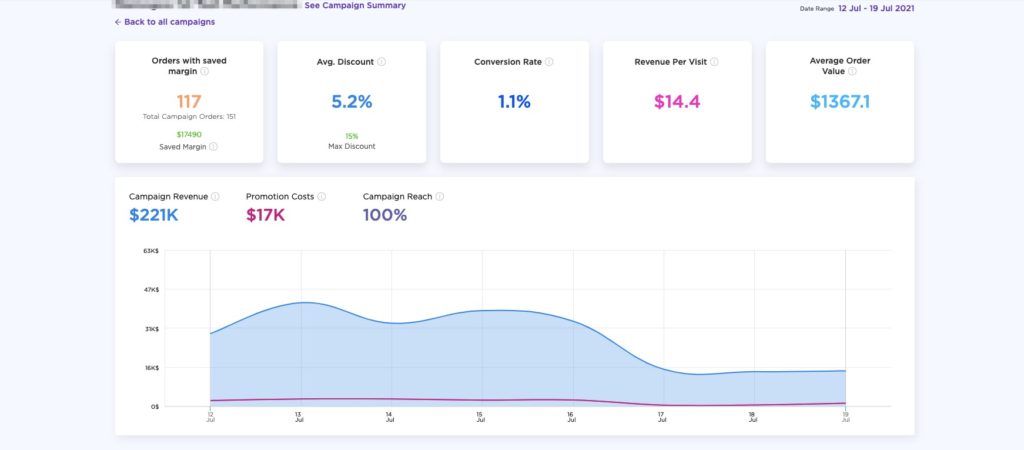
This helped them save $17,000+ in margin across 117 orders for the week.
Ensuring your customers are offered the minimum promotion required to convert will help you protect your margins over BFCM while also driving conversions.
2. Focus on Lowering Your Cart Abandonment Rate
Cart abandonment presents a number of challenges to eCommerce brands beyond just lost revenue.
And the truth is, even if you craft the perfect Black Friday strategy with generous discounts and the perfect timing, an average of 69% of online shoppers who add items to their carts leave before they complete their purchase.
So on top of aiming to increase conversion rate, reducing your cart abandonment rates can make all the difference to the effectiveness of your cyber weekend sales.
Over 50,000 sessions, just a 10% decrease in abandonment rate from 69% to 62% could result in over 100 recovered sales.
Some strategies for reducing cart abandonment rates include:
- Improve your mobile shopping experience, which we’ll dive into shortly.
- Use Intent-Based Promotions to ensure your customers with high intent follow through with their purchase instead of abandoning ship early.
- Add trust signals at checkout to reassure shoppers that your business is legit and creates happy customers.
- Allow people to save their carts for a later checkout. Enable this, and you can send them a deal shortly after to help nudge them into completing their purchase.
- Offer free shipping to shoppers who meet a certain spend threshold.
- Simplify your checkout experience so shoppers can quickly make a purchase and be more likely to do so.
Read More: How to Reduce Shopping Cart Abandonment Rate: 18 Advanced Strategies
3. Start Your Black Friday Deals Earlier This Year (But Not Too Early)
Another strategy you can enlist to drive sales is starting your holiday promotions before the actual date of Black Friday.
Check out how Four Sigmatic launched their 2020 Black Friday sale a few days early with an early access email.

This gives you a chance to capture people before they’ve spent their allotted holiday money somewhere else.
However, you don’t want to start your sales too early, otherwise, you’ll find people waiting to see if there are better deals to be had.
That’s why it’s so crucial to strike the right balance when it comes to choosing your dates. It helps to send out a preview of your sales ahead of time to generate excitement and lock people into your upcoming offers.
4. Consider Extending Your Sales After Cyber Monday Passes
On top of starting your sales earlier, you may also want to give people extra time to make a purchase later.
If they’re busy shopping around for holiday deals, they could easily miss out or forget to take advantage of your offer on time.
By extending your deadline, you’ll capture those people and shoppers who are still deciding what to do.
Keep in mind, your sales should still have an expiration date to trigger urgency.
Read More: The Psychology of Discounts: 8 Strategies Backed By Science to Use in 2021
So don’t mention your sales extension until the date has passed (or customers will just wait and potentially miss it).
Send emails letting people know your Cyber Monday sale ends at midnight, and then let them know at some point closer to this time that you’re in the holiday spirit and plan to extend the deals a bit longer.
This should give indecisive shoppers a second chance to score a deal and help drive even more sales this holiday season.
5. Optimize the User Experience for Your Unique Target Customer
Understanding your target customers is crucial for putting your best foot forward for cyber weekend.
Craft your strategy around the unique customer segments your company targets, including not only their demographics, but their psychographics, behaviors, and intent signals as well.
Use your buyer personas, industry, and the types of customers you attract to:
-
- Personalize the customer experience onsite to meet shopper’s expectations and drive conversions and loyalty.
- Craft a data-driven sales promotion strategy for Black Friday using the data in this guide. For example, a footwear brand like Namogoo customer Allbirds may focus their marketing efforts on Cyber Monday given the sales increases on that day in their industry.
- Nail your mobile shopping experience. Regardless of your core demographics, mobile shopping is prevalent. Ensure your mobile shopping experience is seamless for Black Friday and Cyber Monday. Thoroughly QA your shopping experience on various mobile devices (such as phones, tablets, etc.) to see what your customers would experience. Make sure to try both Android and iOS devices, so there are no discrepancies.
- Personalize the customer experience onsite to meet shopper’s expectations and drive conversions and loyalty.
Craft a Data-Driven BFCM Strategy for 2022
While Cyber Monday and Black Friday sales statistics certainly looked different last year (and may be surprising again this year), there’s still time to make an impact. The key is starting early today.
Follow the five tips for improving your Black Friday marketing outlined in this guide, and you’ll have no trouble capturing holiday traffic and driving sales.
Book a Demo now to see how Intent-Based Promotions can help boost your holiday sales this year and beyond!



